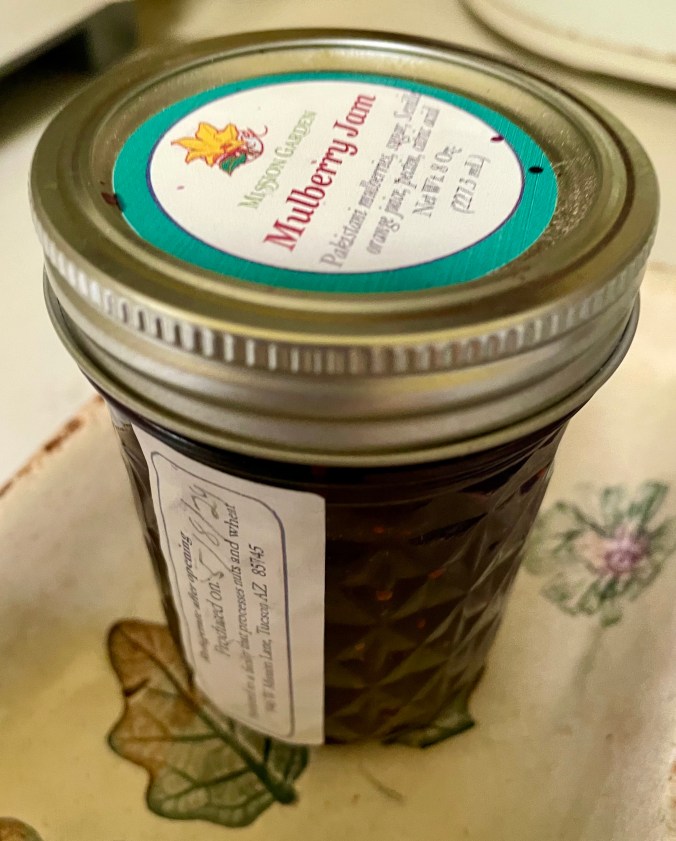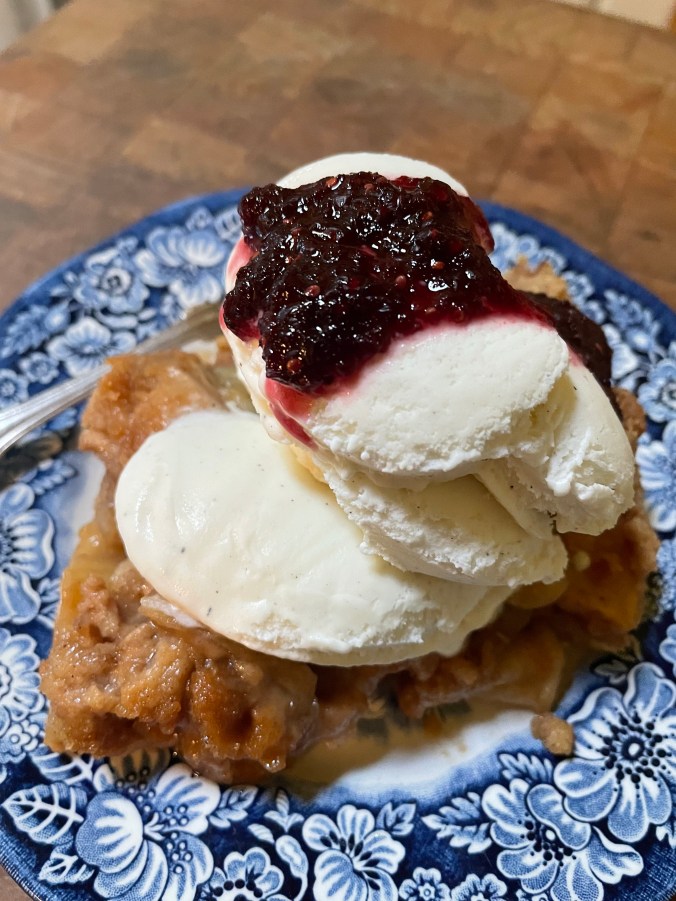
Yummmmm. If you have never tasted a mulberry–or maybe you remember browsing them as a kid back east or in the Midwest–you will be blown away by the glorious mulberry harvest happening right now at Mission Garden!
Tia Marta here tempting your tastebuds for a gentle, natural sweet treat–but…you have to take action SOON. If you’re in southern Arizona, find a hole in your schedule, and a way to get to the base of Tucson’s A-Mountain this week for a mulberry taste-thrill. It will inspire a new planting in your desert home landscape. Three different mulberries await you in Mission Garden’s beautiful and diverse orchards. Come early–summer hours are Wednesday thru Saturday, 8am-noon.

A sumptuous harvest after this wet winter! Look for trees on the Mission Garden grounds that have a big white fabric tarp underneath, and voila! Shake a branch and dive in for a dark, delicious, delicate mulberry, fresh from the tree. The elongated fruit shown here is Pakistani mulberry (Morus alba x rubra), producing like mad even in Tucson’s heat.
Female trees produce fruit. Male, pollen-producing, trees are controversial in Tucson due to allergenic affects. Somewhere out there, there must be male mulberries; none are growing at Mission Garden, yet we have no dearth of fruit.

Handmade mulberry jams are going fast at the Mission Garden entrance shop! It’s the best jam you ever tasted, made with love by Mission Garden volunteers in their health-department-certified kitchen. You can’t find local gourmet delicacies like this commercially. The closest thing (like frozen raspberries at a grocer’s freezer?) can’t hold a candle to Mission Garden mulberry jam or sauce! ($8 for the 8oz. jar)

Mulberry jam doubles as a gourmet sauce. My pedestrian apple-brown-betty morphed into a fancy dessert with ala mode topped by a dollup o’ Mission Garden’s mulberry jam. (Mulberry seeds in the sauce are minimal and add a tiny crunch texture.)


As you explore further through the Mission Period huerta (orchard) you’ll find yet another gorgeous green mulberry tree with a totally different color and shape of fruit. (Above, looking up into the foliage, and ripe fruit adjacent) This is white mulberry (Morus alba) with a pale pink or lavender color, and a flavor some people describe as “watermelon” or “lingonberry” or “cloud berry.” So juicy you can’t stop….


A big surprise is to learn that we have a NATIVE mulberry “bush” in the arid Southwest–the wild, small-leafed mulberry tree (Morus microphylla). It’s inspiring to know it is adapted to our Sonoran Desert, only needing a little extra water; it grows close to arroyos out in Nature. This may be one of those amazing plants that may help provide food for us in a hotter, drier future…

Each little wild mulberry is a zap of sweet nutrition, packed with healthy complex sugars, dietary fiber, beta carotines, vitamin C and iron.
I can hardly wait until Mission Garden is propagating cuttings of all these several amazing mulberry species. Already I’m figuring where I can plant them in my yard. Whatever we can’t harvest each season will be a gift for the birds!
This coming SATURDAY, MAY 18, is SAN YSIDRO FIESTA, Mission Garden’s celebration of the traditional pilkan harvest (heirloom wheat harvest). I’ve been playing with recipes using these heirloom grains pairing them with mulberries, but I HAD to relay this timely mulberry story for you ASAP, so you could get to Mission Garden this week to jump through this narrow “mulberry window” of opportunity.
Tia Marta hoping to see you at San Ysidro Fiesta Saturday–or sooner, browsing a mulberry tree this week!
female mulberry trees are self fruiting. they don’t need a male…
LikeLike
These mulberries, that I tasted for the first time just a few years ago, are the most wonderful fruit in the world! Last year, I attempted to make jam but I ended up with a wonderful mulberry syrup. As a kid, the local mulberries were tart and uninteresting. These, however, are magical.
LikeLike
Muffin, Dynamite article on this magic fruit. I have been taking visitors for a mulberry tasting on each tour. From 18 month old children to adults, they have uttered a lot of accolades. Your article really brings the mulberry and its uses to life.
Thanks, Jerome
LikeLike
Red mulberries were grown and decoy fruit near some of the orchards of the Santa Clara Valley. They kept birds that eat the orchard fruit occupied. I would like to grow them in my home garden, even though the fruit is supposedly not as good as black mulberries.
LikeLike
Fascinating. I’ve never heard of “decoy” fruit!
LikeLiked by 1 person
It has been so long since I have seen them in action that I do not remember how they worked. I remember that some varieties or cultivars were used as decoys for particular cultivars of fruit that ripened at the same time. For example, there were mulberries that matched the ripening of French prunes, and other mulberries that matched the ripening of ‘Moorpark’ apricots, and so on. I believe that they were red mulberries, but the fruit was very dark, like black mulberries. Also, because I do not remember male pollinators, I suspect that the few that I remember may have been black mulberries. I do not remember any mulberry orchards, and because most fruit of the Santa Clara Valley was grown for drying or canning, I doubt that there were any. Also, except for a few old decoy trees that remained as homes were built around them, mulberries were very rare in home gardens. Even now, not many people here know what they are. Do you find unimproved red mulberry to be too inferior to cultivars of black mulberry?
LikeLike